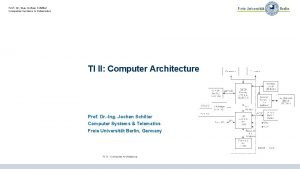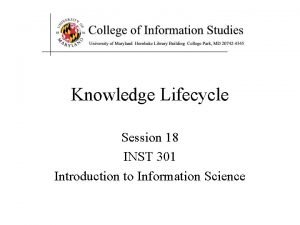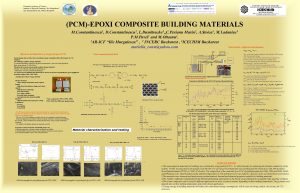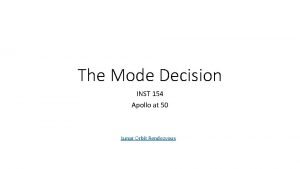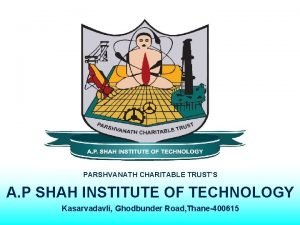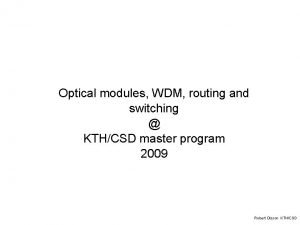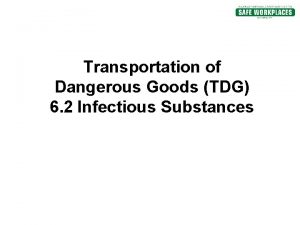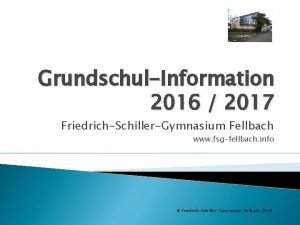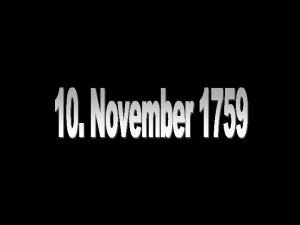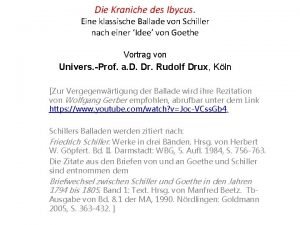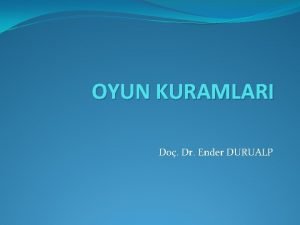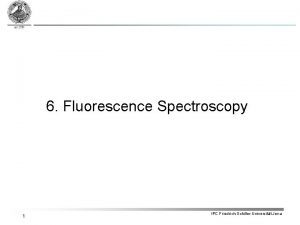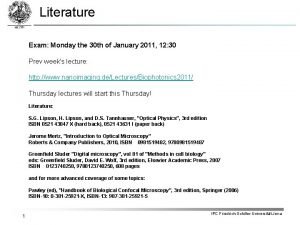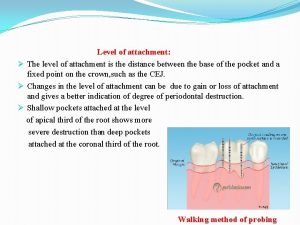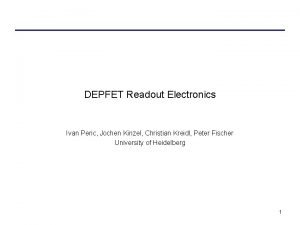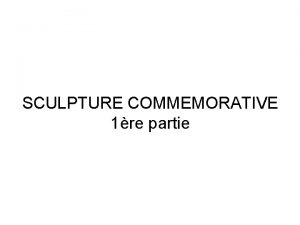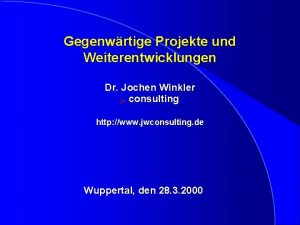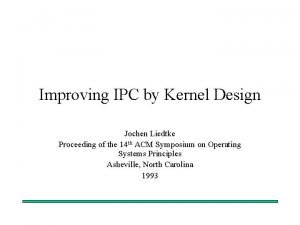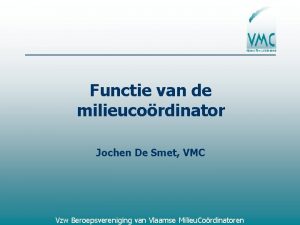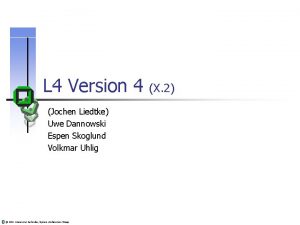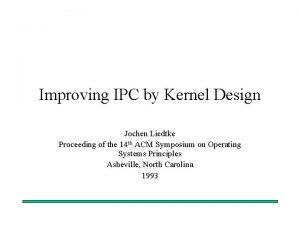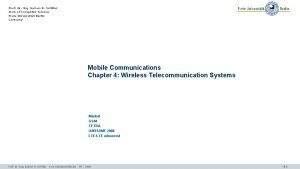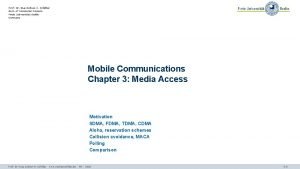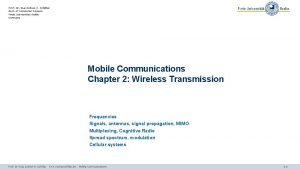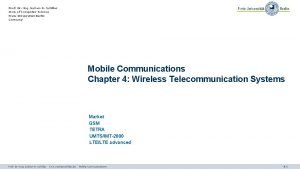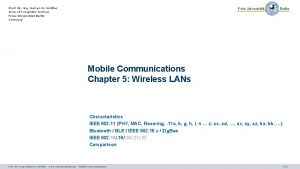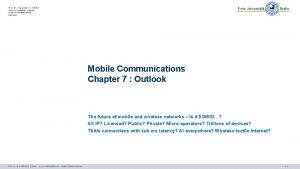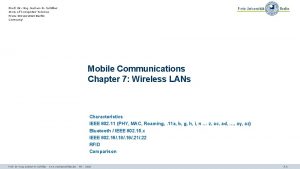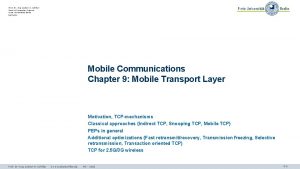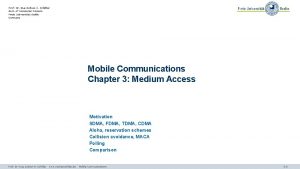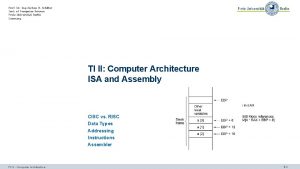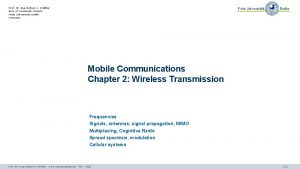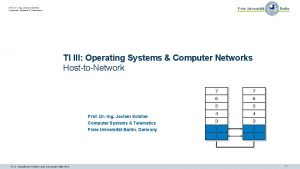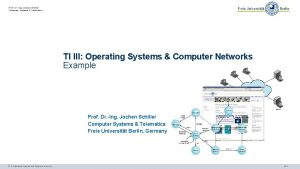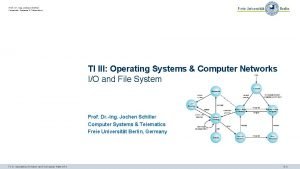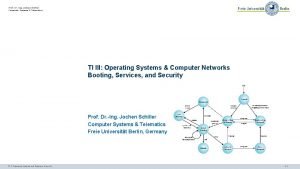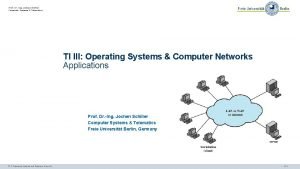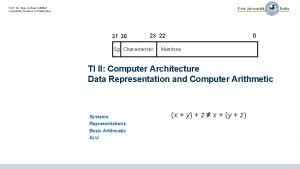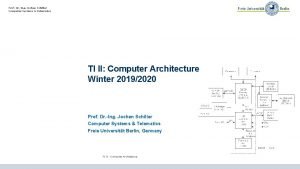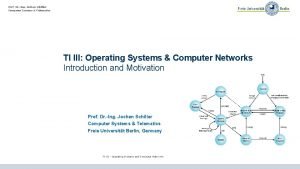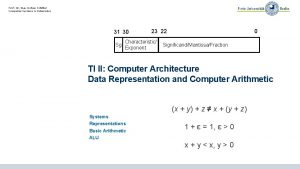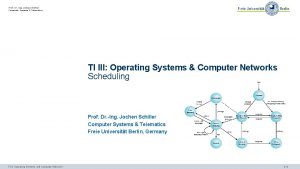Prof Dr Ing Jochen H Schiller Inst of



































- Slides: 35

Prof. Dr. -Ing Jochen H. Schiller Inst. of Computer Science Freie Universität Berlin Germany Mobile Communications - an Overview Freie Universität Berlin - Computer Systems & Telematics Prof. Dr. -Ing. Jochen H. Schiller www. jochenschiller. de schiller@computer. org Prof. Dr. -Ing. Jochen H. Schiller www. jochenschiller. de Mobile Communications 1. 1

Why Mobile Communications? Source: https: //www. funktel. international/ Source: https: //riot-os. org/ Largest SW/HW/networked system Largest number of subscribers Mobile devices dominate the Internet Mobile applications dominate Internet usage New possibilities, new threats Technology fully integrated into everybody's life almost 24/7, almost anywhere Internet of Everything needs mobile/wireless access Source: https: //www. apple. com/ Prof. Dr. -Ing. Jochen H. Schiller www. jochenschiller. de Source: https: //www. samsung. com/ Mobile Communications 1. 2

Overview of the lecture - Introduction - Wireless LANs/PANs - Use-cases, applications - Challenges, history - Basic Technology - IEEE 802. 11 a/b/g/…, . 15, Bluetooth, Zig. Bee - Wireless Transmission - Internet Protocols - Frequencies & regulations, Cognitive Radio - Signals, antennas, signal propagation, MIMO - Multiplexing, modulation, spread spectrum, cellular system, SDR - Medium Access - SDMA, FDMA, TDMA, CDMA - CSMA/CA, versions of Aloha, Collision avoidance, polling - Mobile IP Locator/Identifier split Ad-hoc networking Routing Transport Protocols Io. T - Outlook - Beyond LTE, 5 G - Wireless Telecommunication Systems - GSM, GPRS, TETRA, UMTS, IMT-2000, LTE Prof. Dr. -Ing. Jochen H. Schiller www. jochenschiller. de Mobile Communications 1. 3

Prof. Dr. -Ing Jochen H. Schiller Inst. of Computer Science Freie Universität Berlin Germany Mobile Communications Chapter 1: Introduction A case for mobility – many aspects History of mobile communication Market Areas of research Prof. Dr. -Ing. Jochen H. Schiller www. jochenschiller. de Mobile Communications 1. 4

Computers for the next decades? Computers are integrated (>95% embedded systems!) - small, cheap, portable, replaceable - no more separate devices (see M. Weiser/invisible computer) Technology is in the background - computer are aware of their environment and adapt (“location awareness”) - computer recognize the location of the user and react appropriately (e. g. , call forwarding, message forwarding, “context awareness”) Advances in technology - more computing power in smaller devices - flat, lightweight displays with low power consumption - new user interfaces due to small dimensions - more bandwidth per cubic meter - multiple wireless interfaces: NFC, piconets, wireless LANs, wireless WANs, regional wireless telecommunication networks, VLC etc. Prof. Dr. -Ing. Jochen H. Schiller www. jochenschiller. de Mobile Communications 1. 5

Mobile communication Two aspects of mobility: - user mobility: users communicate (wireless) “anytime, anywhere, with anyone” - device portability: devices can be connected anytime, anywhere to the network Wireless vs. mobile Examples high performance cluster notebook in a hotel, on-board networks wireless LANs in historic buildings, ad-hoc infrastructure replacement Smartphone The demand for mobile communication created already decades ago the need for integration of wireless networks into existing fixed networks: - local area networks: standardization of IEEE 802. 11 - Internet: Mobile IP extension of the internet protocol IP - wide area networks: e. g. , internetworking of GSM and ISDN, Vo. IP over WLAN and POTS Prof. Dr. -Ing. Jochen H. Schiller www. jochenschiller. de Mobile Communications 1. 6

Applications I Vehicles - transmission of news, road condition, weather, music/video via DAB+/DVB-T 2/LTE - personal communication using GSM/UMTS/LTE - positioning via GPS/Galileo/Glonass/Beidou - local ad-hoc network with vehicles close-by to prevent accidents, guidance system, redundancy - vehicle data (e. g. , from busses, high-speed trains) can be transmitted in advance for maintenance Emergencies - early transmission of patient data to the hospital, current status, first diagnosis - replacement of a fixed infrastructure in case of earthquakes, hurricanes, fire etc. - crisis, war, . . . Prof. Dr. -Ing. Jochen H. Schiller www. jochenschiller. de Mobile Communications 1. 7

Typical application: road traffic UMTS, WLAN, DAB+, LTE, GSM, cdma 2000, TETRA, . . . ad c ho Smartphone, Laptop, Tablet, LTE, GSM, UMTS, WLAN, Bluetooth, NFC. . . Prof. Dr. -Ing. Jochen H. Schiller www. jochenschiller. de Mobile Communications 1. 8

Mobile and wireless services – Always Best Connected DSL/ WLAN 50 Mbit/s GSM/GPRS 53 kbit/s Bluetooth 500 kbit/s LTE 10 Mbit/s LAN 1 Gbit/s, WLAN 300 Mbit/s UMTS 2 Mbit/s GSM/EDGE 384 kbit/s, DSL/WLAN 6 Mbit/s GSM 115 kbit/s, WLAN 11 Mbit/s Prof. Dr. -Ing. Jochen H. Schiller www. jochenschiller. de Mobile Communications UMTS, GSM 384 kbit/s 1. 9

Applications II Traveling salesmen - direct access to customer files stored in a central location - consistent databases for all agents - mobile office Replacement of fixed networks - remote sensors, e. g. , weather, earth activities - flexibility for trade shows - LANs in historic buildings History Info Entertainment, education, . . . - outdoor Internet access - intelligent travel guide with up-to-date location dependent information - ad-hoc networks for multi user games Prof. Dr. -Ing. Jochen H. Schiller www. jochenschiller. de Mobile Communications 1. 10

Location dependent services Location aware services - what services, e. g. , printer, phone, server etc. exist in the local environment Follow-on services - automatic call-forwarding, transmission of the actual workspace to the current location Information services - “push”: e. g. , current special offers in the supermarket - “pull”: e. g. , where is the Black Forrest Cheese Cake? Support services - caches, intermediate results, state information etc. “follow” the mobile device through the fixed network Privacy - who should gain knowledge about the location Prof. Dr. -Ing. Jochen H. Schiller www. jochenschiller. de Mobile Communications 1. 11

Mobile devices Specialized PDAs • graphical displays • character recognition • application specific • ruggedized Laptop/Notebook/Convertible • fully functional • standard applications Sensors, embedded controllers Smart dust Classical mobile phones • voice, data • simple graphical displays • robust, water proof Smartphone/Tablet • tiny virtual keyboard • voice recognition • simple(r) versions of standard applications performance No clear separation between device types possible (e. g. smart phones, embedded PCs, …) Prof. Dr. -Ing. Jochen H. Schiller www. jochenschiller. de Mobile Communications 1. 12

Effects of device portability Power consumption - limited computing power, low quality displays, small disks due to limited battery capacity - CPU: power consumption ~ CV²f - C: internal capacity, reduced by integration - V: supply voltage, can be reduced to a certain limit - f: clock frequency, can be reduced temporally Source: https: //www. welectron. com/ Loss of data - higher probability, has to be included in advance into the design (e. g. , defects, theft) Limited user interfaces - compromise between size of fingers and portability - integration of character/voice recognition, abstract symbols Limited fast memory (always in relation to e. g. PCs) - Limited/no usage of mass memories with moving parts - flash-memory or ? as alternative Source: https: //www. catphones. com/ Prof. Dr. -Ing. Jochen H. Schiller www. jochenschiller. de Mobile Communications 1. 13

Wireless networks in comparison to fixed networks Higher loss-rates due to interference - emissions of, e. g. , engines, lightning Restrictive regulations of frequencies - frequencies have to be coordinated, useful frequencies are almost all occupied Lower transmission rates - local some Mbit/s, regional sometimes only, e. g. , 53 kbit/s with GSM/GPRS or about 150 kbit/s using EDGE – some Mbit/s with LTE (shared!) – compare country side vs. downtown Higher delays, higher jitter - connection setup time with GSM in the second range, several hundred milliseconds for other wireless systems – in ms range with LTE Lower security, simpler active attacking - radio interface accessible for everyone, base station can be simulated, thus attracting calls from mobile phones Always shared medium - secure access mechanisms important Prof. Dr. -Ing. Jochen H. Schiller www. jochenschiller. de Mobile Communications 1. 14

Questions & Tasks - Compare theoretical (and often announced) values for transmission data rates with realistic data rates. What could be reasons for the sometimes big difference? - How do fixed and wireless systems differ in this context? - Compare advances in CPU power, displays, batteries, applications, data rates. What are limiting factors of today? - Go to the web sites of the three big organizations that push forward standardization of mobile and wireless communication (among many other organizations): for LANs http: //grouper. ieee. org/groups/802/index. shtml, for the Internet https: //www. ietf. org/ and for WANs https: //www. 3 gpp. org/. Find out how they do their standardization! - What are pros and cons regarding push or pull services? Prof. Dr. -Ing. Jochen H. Schiller www. jochenschiller. de Mobile Communications 1. 15

Early history of wireless communication Many people in history used light for communication - heliographs, flags (“semaphore”), . . . - 150 BC smoke signals for communication; (Polybius, Greece) - 1794, optical telegraph, Claude Chappe Here electromagnetic waves are of special importance: - 1831 Faraday demonstrates electromagnetic induction - J. Maxwell (1831 -79): theory of electromagnetic Fields, wave equations (1864) - H. Hertz (1857 -94): demonstrates with an experiment the wave character of electrical transmission through space (1886, in Karlsruhe, Germany) Prof. Dr. -Ing. Jochen H. Schiller www. jochenschiller. de Mobile Communications 1. 16

History of wireless communication I 1896 Guglielmo Marconi - first demonstration of wireless telegraphy (digital!) - long wave transmission, high transmission power necessary (> 200 k. W) 1907 Commercial transatlantic connections - huge base stations (30 100 m high antennas) 1915 Wireless voice transmission New York - San Francisco 1920 Discovery of short waves by Marconi - reflection at the ionosphere - smaller sender and receiver, possible due to the invention of the vacuum tube (1906, Lee De. Forest and Robert von Lieben) 1926 Train-phone on the line Hamburg - Berlin - wires parallel to the railroad track Prof. Dr. -Ing. Jochen H. Schiller www. jochenschiller. de Mobile Communications 1. 17

History of wireless communication II 1928 many TV broadcast trials (across Atlantic, color TV, news) 1933 Frequency modulation (E. H. Armstrong) 1958 A-Netz in Germany - analog, 160 MHz, connection setup only from the mobile station, no handover, 80% coverage, 1971 11000 customers 1972 B-Netz in Germany - analog, 160 MHz, connection setup from the fixed network too (but location of the mobile station has to be known) - available also in A, NL and LUX, 1979 13000 customers in D 1979 NMT at 450 MHz (Scandinavian countries) 1982 Start of GSM-specification - goal: pan-European digital mobile phone system with roaming 1983 Start of the American AMPS (Advanced Mobile Phone System, analog) 1984 CT-1 standard (Europe) for cordless telephones Prof. Dr. -Ing. Jochen H. Schiller www. jochenschiller. de Mobile Communications 1. 18

History of wireless communication III 1986 C-Netz in Germany - analog voice transmission, 450 MHz, hand-over possible, digital signaling, automatic location of mobile device - was in use until 2000, services: FAX, modem, X. 25, e-mail, 98% coverage 1991 Specification of DECT - Digital European Cordless Telephone (today: Digital Enhanced Cordless Telecommunications) - 1880 -1900 MHz, ~100 -500 m range, 120 duplex channels, 1. 2 Mbit/s data transmission, voice encryption, authentication, up to several 10000 user/km 2, used in more than 50 countries 1992 Start of GSM - in D as D 1 and D 2, fully digital, 900 MHz, 124 channels - automatic location, hand-over, cellular - roaming in Europe - now worldwide in more than 200 countries - services: data with 9. 6 kbit/s, FAX, voice, . . . Prof. Dr. -Ing. Jochen H. Schiller www. jochenschiller. de Mobile Communications 1. 19

History of wireless communication IV 1994 E-Netz in Germany - GSM with 1800 MHz, smaller cells - as Eplus in D (1997 98% coverage of the population) 1996 Hiper. LAN (High Performance Radio Local Area Network) - ETSI, standardization of type 1: 5. 15 - 5. 30 GHz, 23. 5 Mbit/s - recommendations for type 2 and 3 (both 5 GHz) and 4 (17 GHz) as wireless ATM-networks (up to 155 Mbit/s) 1997 Wireless LAN - IEEE 802. 11 - IEEE standard, 2. 4 - 2. 5 GHz and infrared, 2 Mbit/s - already many (proprietary) products available in the beginning 1998 Specification of GSM successors - for UMTS (Universal Mobile Telecommunications System) as European proposals for IMT-2000 - Iridium - 66 satellites (+6 spare), 1. 6 GHz to the mobile phone Prof. Dr. -Ing. Jochen H. Schiller www. jochenschiller. de Mobile Communications 1. 20

History of wireless communication V 1999 Standardization of additional wireless LANs - IEEE standard 802. 11 b, 2. 4 -2. 5 GHz, 11 Mbit/s - Bluetooth for piconets, 2. 4 GHz, <1 Mbit/s - decision about IMT-2000 - several “members” of a “family”: UMTS, cdma 2000, DECT, … - Start of WAP (Wireless Application Protocol) and i-mode - first step towards a unified Internet/mobile communication system - access to many services via the mobile phone 2000 GSM with higher data rates - HSCSD offers up to 57, 6 kbit/s - first GPRS trials with up to 50 kbit/s (packet oriented!) - UMTS auctions/beauty contests - Hype followed by disillusionment (50 B$ paid in Germany for 6 licenses!) - Iridium goes bankrupt 2001 Start of 3 G systems - Cdma 2000 in Korea, UMTS tests in Europe, Foma (almost UMTS) in Japan Prof. Dr. -Ing. Jochen H. Schiller www. jochenschiller. de Mobile Communications 1. 21

History of wireless communication VI 2002 - WLAN hot-spots start to spread 2003 - UMTS starts in Germany - Start of DVB-T in Germany replacing analog TV 2005 - Wi. Max starts as DSL alternative (not mobile) - first Zig. Bee products 2006 - HSDPA starts in Germany as fast UMTS download version offering > 3 Mbit/s - WLAN draft for 250 Mbit/s (802. 11 n) using MIMO - WPA 2 mandatory for Wi-Fi WLAN devices 2007 - over 3. 3 billion subscribers for mobile phones (NOT 3 bn people!) 2008 - “real” Internet widely available on mobile phones (standard browsers, decent data rates) - 7. 2 Mbit/s HSDPA, 1. 4 Mbit/s HSUPA available in Germany, more than 100 operators support HSPA worldwide, first LTE tests (>100 Mbit/s) 2009 – the story continues with netbooks, i. Phone, Vo. IPo. WLAN… 2010 – LTE available in some cities, new frequencies allocated - Reuse of old analog TV bands, LTE as DSL replacement for rural areas 2015 – Vo. LTE, LTE@700 MHz, LTE advanced 2020 – Start of 5 G Prof. Dr. -Ing. Jochen H. Schiller www. jochenschiller. de Mobile Communications 1. 22

Questions & Tasks - The history of wireless and mobile communication is not only a history of successes, but also failures. Iridium, Hiper. LAN, WAP, Wi. Max are examples. Find reasons for their failure (or at least limited success)! - Check the current, newest standards for mobile communications (3 gpp), WLAN (IEEE), PANs (Zigbee, Bluetooth) Prof. Dr. -Ing. Jochen H. Schiller www. jochenschiller. de Mobile Communications 1. 23

Worldwide wireless subscribers (old prediction 1998) 700 600 500 Americas Europe Japan others total 400 300 200 100 0 1996 1997 1998 1999 2000 2001 2014 more than 7 billion subscriptions – be aware: this includes many devices! Prof. Dr. -Ing. Jochen H. Schiller www. jochenschiller. de Mobile Communications 1. 24

Mobile phones per 100 people 1999 Germany Greece Spain Belgium France Netherlands Great Britain Switzerland Ireland Austria Portugal Luxemburg Italy Denmark Norway Sweden Finland 0 10 20 30 40 50 60 2005: 70 -90% penetration in Western Europe, 2009 (ten years later): > 100% – 2016: 96% worldwide! Prof. Dr. -Ing. Jochen H. Schiller www. jochenschiller. de Mobile Communications 1. 25

Global ICT developments, 2005 -2019 Prof. Dr. -Ing. Jochen H. Schiller www. jochenschiller. de Mobile Communications 1. 26

Mobile-cellular subscriptions, 2001 -2016 Prof. Dr. -Ing. Jochen H. Schiller www. jochenschiller. de Mobile Communications 1. 27

Mobile-cellular subscriptions per region per 100 inhabitants 2019 Prof. Dr. -Ing. Jochen H. Schiller www. jochenschiller. de Mobile Communications 1. 28

Mobile population coverage by type of network 2007 -2019 Prof. Dr. -Ing. Jochen H. Schiller www. jochenschiller. de Mobile Communications 1. 29

Questions & Tasks - Check https: //www. itu. int for up-to-date figures - Additionally, look at https: //www. 3 gpp. org/ - Currently, network operators roll-out 5 G technology (covered later in this course). Figure out the strategies of the different network operators while migrating towards 5 G systems. Can you find reasons why a single common system is not in sight? - 4 G or higher coverage is flattening way before reaching the world population. Give reasons! Prof. Dr. -Ing. Jochen H. Schiller www. jochenschiller. de Mobile Communications 1. 30

Areas of research in mobile and wireless communication Wireless Communication - transmission quality (bandwidth, error rate, delay) - modulation, coding, interference - medium access, regulations -. . . Mobility - location dependent services - location transparency - quality of service support (delay, jitter, security) -. . . Portability - power consumption - limited computing power, sizes of display, . . . - usability -. . . … and as always: security (privacy, data integrity, tracking, encryption, law enforcement…)! Prof. Dr. -Ing. Jochen H. Schiller www. jochenschiller. de Mobile Communications 1. 31

Simple reference model used here Application Transport Network Data Link Physical Radio Prof. Dr. -Ing. Jochen H. Schiller www. jochenschiller. de Mobile Communications Network Data Link Physical Medium 1. 32

Influence of mobile communication to the layer model service location new/adaptive applications multimedia congestion/flow control quality of service addressing, routing device location hand-over authentication media access/control multiplexing encryption modulation interference attenuation frequency Application layer Transport layer Network layer Data link layer Physical layer Prof. Dr. -Ing. Jochen H. Schiller www. jochenschiller. de Mobile Communications 1. 33

Seamless Overlay Networks – (still) the global goal integration of heterogeneous fixed and mobile networks with varying transmission characteristics regional vertical handover metropolitan area 5 G campus-based horizontal handover in-house Prof. Dr. -Ing. Jochen H. Schiller www. jochenschiller. de Mobile Communications 1. 34

Questions & Tasks - This course requires sound knowledge in fixed computer networks, layering, protocols etc. So please refresh your knowledge with our Computer Networks lecture, books, tutorial … - The principle of layering, the task of the layers, the Internet protocol family should be familiar! - Where do you use horizontal handover since many years? - What about vertical handovers? Give examples where they already exist! - What are problems for vertical handovers? - The data rate of LTE is already higher than many DSL connections (> 100 Mbit/s) – so why doing more research? Can’t we just replace all DSL connections by LTE – problem solved? Prof. Dr. -Ing. Jochen H. Schiller www. jochenschiller. de Mobile Communications 1. 35
 Jochen schiller
Jochen schiller Inst 301
Inst 301 Hresca inst
Hresca inst Inst154
Inst154 Inst eecs
Inst eecs Apsit moodle
Apsit moodle Inst
Inst Aafbr
Aafbr Inst-154
Inst-154 Royal inst
Royal inst Rubiterm
Rubiterm Iata special provision a140
Iata special provision a140 Definition entwicklungsroman
Definition entwicklungsroman Trochäus
Trochäus Die bürgschaft inhaltsangabe 7. klasse
Die bürgschaft inhaltsangabe 7. klasse Gymnasium fellbach
Gymnasium fellbach Der handschuh schiller comic
Der handschuh schiller comic Corps de schiller duval
Corps de schiller duval Die kraniche des ibykus gedicht
Die kraniche des ibykus gedicht özünü yineleme kuramı
özünü yineleme kuramı Bosnian serial killer
Bosnian serial killer Ipc jena
Ipc jena Anatomie varlete
Anatomie varlete Choregos vase
Choregos vase Cylinder
Cylinder Gingival attachment
Gingival attachment Hans jochen schiewer
Hans jochen schiewer Jochen kinzel
Jochen kinzel Jochen gerz monument contre le racisme
Jochen gerz monument contre le racisme Jochen winkler
Jochen winkler Jochen liedtke
Jochen liedtke Actorenmatrix
Actorenmatrix Jochen liedtke
Jochen liedtke Jochen wambach
Jochen wambach Jochen liedtke
Jochen liedtke Nestls
Nestls
